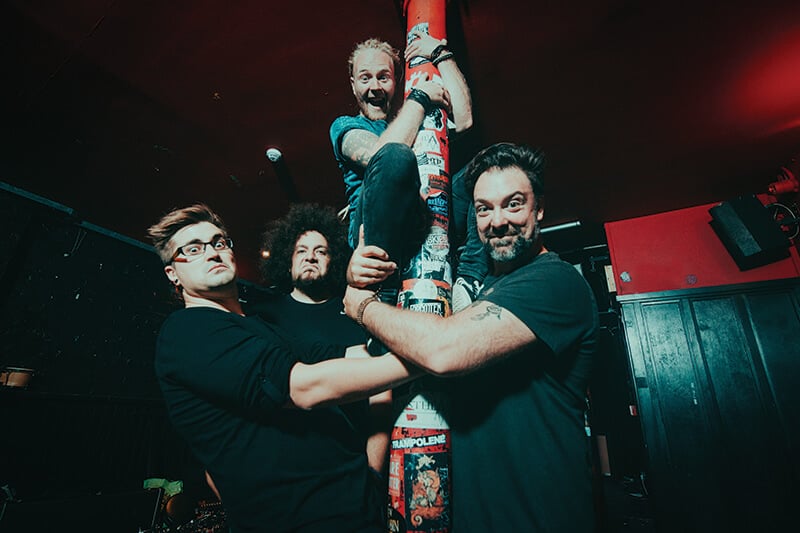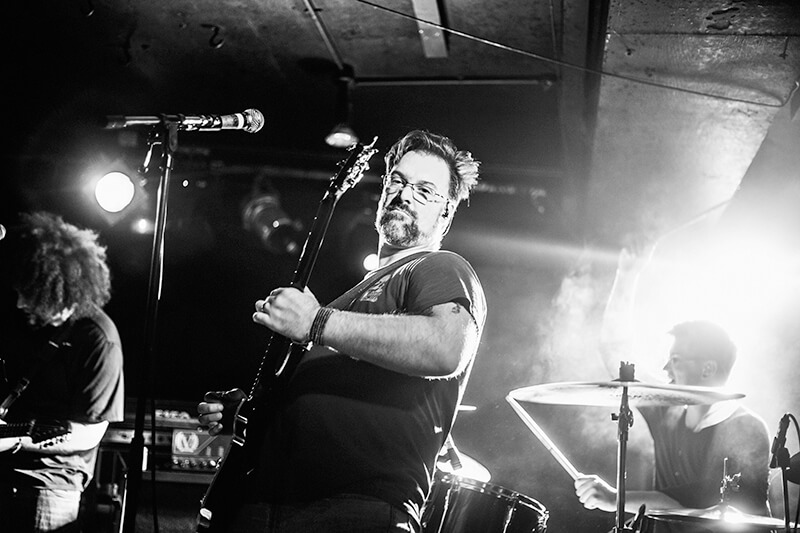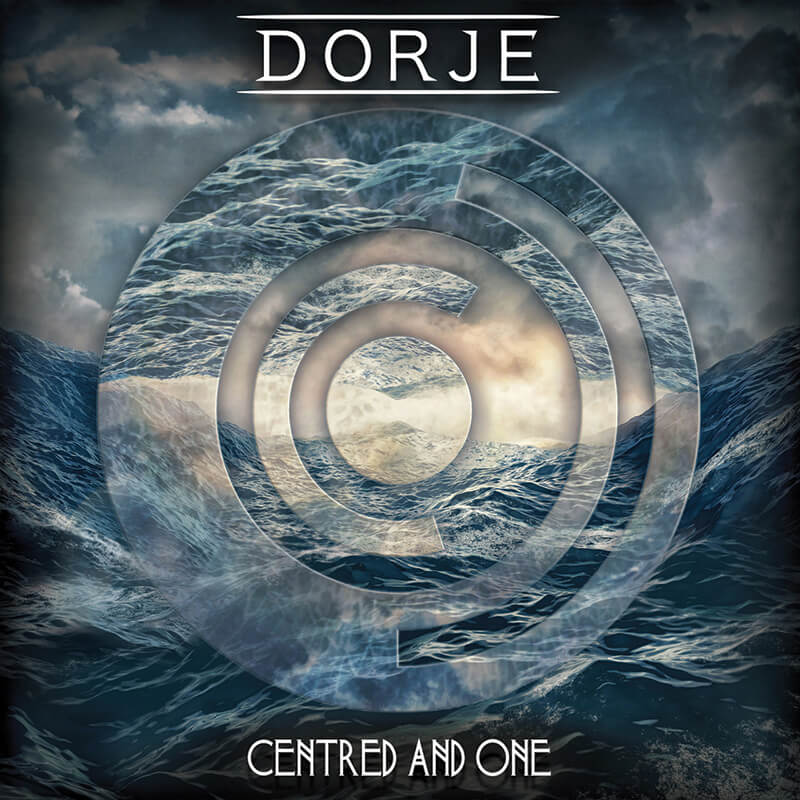When we last caught up with Rob Chapman [see December 2014 cover story], the guitarist was in the midst of signing a major European distribution deal with Thomann for his line of Chapman Guitars, and had basically revolutionized the way we thought about guitar design. By tapping into the collaborative nature of the Internet, Chapman was able to unite an army of guitarists to help inspire the various models of Chapman Guitars on the market today. We’ve reviewed both the ML1 and the Ghost Fret models in the past, and had a good cry in the office when said guitars had to be returned.
For most of us, those would be enough accomplishments to fill a lifetime. But Chapman, or Chappers, as he’s affectionately known on YouTube, is not one to rest on his laurels. Since our last encounter, the musician has pushed full-steam ahead with his own original music in the UK-based band, Dorje. The group’s video for “Catalyst” has seen over one million spins on YouTube, and the band has just dropped its latest, and most bone-crushing collection of music, in the form of an EP titled Centred and One. With it, we find Rob’s vocals the strongest of his career, and the band at its tightest, most cohesive and downright brutal (try replicating that final scream in “Flower of Life” without blowing your vocal cords).
We chatted with Rob once again to talk about Chapman Guitars, his work in Dorje and the hectic life of an entrepreneur.
Rob, since the last time we spoke, there’s been significant growth with Chapman Guitars. Can you talk about that?
It’s mind blowing, to be honest with you. I think, though I can’t verify this, but we might be the biggest guitar company in the UK right now.

It’s hard to think of other British guitar companies competing at that level right now…
There are some really amazing luthiers and small companies, but really very few companies that manufacture OEM, overseas, and get them into stores all over the world [like we do]. I know Brian May has a company, and he makes the Red Special, and there are a couple of really cool smaller bands. But aside from a brand called Vintage, I don’t know of anybody else who does what we do. We might be a rarity.
We’ve hit a few milestones, and it’s been a helluva ride. It’s really just been us working from our living rooms – we don’t have a headquarters or anything. All of us do what we need to do when we can.
What other markets have you expanded into outside of Europe?
Oh, man. Thailand, Malaysia, Singapore…I don’t like to get complacent, I like to tell myself we’re doing really badly and get surprised when we’re not [laughs]. So, for example, we’re in Columbia, we’re in Israel, all over Australia, New Zealand, and then loads in Europe. Places like Budapest and Poland and those sorts of places.
[The Unites States] has been a bit harder. There’s a lot of dominance by some of the bigger brands. We really wanted to get a network of mom and pop stores, and so far, we have nine retailers in America. Not many, but like I said it’s probably because they don’t have a lot of cash to play with, and Chapman Guitars is a very different kind of company. So it takes a little more for a retailer to come on board, but the rewards are a bit higher.
What I mean is it costs a bit more because we have a minimum order – they have to order from our factory and arrange the shipping, they need to have a brick and mortar store, and they need to have a tech who can set up guitars. Because normally with distribution, that’s done for you. So there’s a lot more pressure on the retailer to do the work, but once they’re in they can order as few as they like and things become much easier for American [retailers].

Rob Chapman of Dorje
You’ve also brought on board a number of new endorsing artists. Is that a way for you to reach more Americans and more serious players?
That’s a very interesting question. Traditionally you’d get artists on board to reach more people. However, with us, it’s always been the case that the biggest artist on board is me [laughs]. I always found that a little bit difficult to deal with. And the truth is, if I make friends with a guy and I think they’re really cool, and I respect them as a musician, as a musician myself, I just want to help them. I genuinely mean this, I just love saying to a guy, ‘Hey man, let’s make something really cool.’ Like with [Chapman endorser] Rob Scallon – it was a really exciting experience.
It’s why you’ll notice that some of our artists, they don’t have a huge following. They’re not famous guys, no one else is gonna sign them up. But I will, because I recognize in them the spark that I had as a young artist, kicking ass on YouTube and taking names. And I know that they need that push and they’re going places. Mostly it’s YouTube guys because that’s the world I live in, and the people I mix with. I hang out with them, have beers with them. What you’re really looking at is my social group, who happen to be great guitar players.
What about future growth for Chapman Guitars?
Let me say this, we’re actually in no rush to grow Chapman Guitars [laughs]. We just don’t have the staff to do it. What we want is for the most natural, organic growth possible. If we were to start approaching [big] bands and retaining them, A) it would seem artificial because I’d want the artist to be genuinely interested in the Chapman brand. And B) we just couldn’t cope with the growth. I much prefer the method of finding people who you know will benefit, who will really work hard, who are dedicated musicians who love the art and are doing it for the right reasons.
[At this point we have a rather candid discussion about Brexit, leek soup and various non-guitar related things that would interest no one but us. To recap a rather convoluted serious of tangents, Rob confirms that pedals are in the planning stages for Chapman Guitars, although amplifiers may prove to be too difficult and risky, and that the company is exploring options to make Chapman-branded acoustics in Europe. Moving on…]
When you went to Korea to visit the factory that makes Chapman Guitars, were you surprised to see how much hand-work was involved in the finishing process?
I was aware of how much they needed to do. What I wasn’t aware of were the conditions you’d find in Korea. What you tend to hear is how awful it is in other countries. Some of the places where they manufacture guitars are in third-world countries. So when I went to Korea, I was just amazed. It was regular dudes like you and me with iPhones, chilling out, making guitars and enjoying it. I’m not sure if many of the staff play guitar, but really it was a lot like Japan [in terms of good working conditions].

Rob Chapman live
Is there a bias in the UK, like there is in the States, about country of origin when it comes to guitars?
I call it industry racism. To be honest, I used to feel that way. When I learned to play guitar, everyone said American-made guitars were the best. The more I’ve learned about manufacturing guitars, the more I realized it has less to do with the country, and more to do with the factory. And it’s less to do with the factory and more to do with the budget you give them. And it’s less to do with the budget you give them, and more to do with the information you give them. Because they’ll literally do exactly what you tell them. ‘Well, you didn’t tell us you wanted the tuner holes in a straight line.’ [laughs] If you give a factory of skilled laborers every bit of information they need, and the budget to build it, then you get great quality instruments.
Can we talk about Dorje? What’s your writing process with the band?
The way it’s kind of settled into, gradually, is that I’ll generate a riff, or Rabea [Massaad, guitar] will write a riff, and we’ll jam and get a song structure. With that in mind, Rabea will make a demo, which I’ll then cut vocals to. But often, I’ll get lyrics in the studio while we’re working.
Very rarely will I sit down to write. Generally, I’ll sit down with a coffee in the evening to play, and that’s when I’ll get an idea. It is mostly Rabea and I bringing the ideas and then we [as a band] hash that out in a room. And more recently, Rabea’s written things on his own, and demo’d them for us to listen to.
You get a vibe for what’s what, since Rabea and I write in different styles. Dorje is basically when Rabea backs off on his craziness, and I back off on my blues and country-ness, and we get a little bit of magic [in the middle]. We instantly know when it’s a Dorje tune.
I don’t want this to come out the wrong way, so I apologize in advance. But your vocals on the new release are a big step up for you. There seems to be a confidence level with your vocals that now seems to match the confidence in your guitar playing. Can you speak to what’s changed for you as a singer on this release?
I’ll tell you exactly what it is. I got a vocal lesson from Brett Manning, and I spent months and months working really, really hard [on my vocals]. If you want to get technical, I learned to sing in an upper mix. So what I was doing previously, was all this lower operatic voice that I was using heat on.
And what I learned was to use a mix, blending my head and my chest voice to get a much higher range, much easier using less breath, applying heat in a more natural way. It gave me double the range. It was ridiculous; it’s also much easier to steer a mixed voice than what I had been doing.
Now, I really enjoy singing. With Dorje, I could take or leave the guitar, really. I could play or not, it’s whatever works for the tune. Finally, I feel I’m comfortable grabbing a mic and singing live.
When it comes to guitars in the studio, what’s your preferred method of recording parts? Are you still miking cabs, or are you working with modeling amps and software?
Miking cabs, all the time. We really enjoy the process [of using amps]. We would expect to spend at least a day, two days, miking up and getting tones. So many amps[laughs] and we had three different cabs for the guitar work, loads of mics, and everything is triple tracked – desaturated clean tones, left and right, crunch and hi-gain. It’s tracked mega-tight, so it takes us hours [to get it right].
The trick is to be really nuts-on, but not.
If it’s nuts-on exactly, sometimes it sounds false. Like it’s just a doubler. So you have to be tight, but not too tight.
When you tour, do you take a full rig? I know you’ve tested the Kemper recently on YouTube…
For this tour I’ll be taking a Victory Red Dwarf, since it’s just seven days and medium-sized venues. I love the Kemper, but it’s still new to me. So for the ease of use [this time around] I’ll take the Red Dwarf out with a 2×12 cab.
Rabea is able to take over my amplifier on stage. So when I’m just singing or not playing guitar, he takes over my rig so it’s always coming out both sides of the stage.
Do you travel with a stripped-down pedal board with Dorje?
Yeah…I don’t really like having anything on the stage in front of me. It gets in the way – if you’re trying to sing and be a frontman, it’s hard enough. Trying to deal with pedals, it’s a pain in the ass. It’s not easy. So I generally take out a delay, a boost, a gain pedal, tuner, maybe a wah and that’s it, really. My guitar playing, live, is really in a supportive role, or I’m playing lead. I love it, actually.
[Editor’s note – Rob and I break here after a quick discussion about the upcoming NAMM show, at which point Rob shares some awesome news that he’ll be making public shortly. And with that, we make a promise to grab a beer in the future. A future, which, if Chapman’s vision stays on course, will continue to remain bright.]

Dorje Centred and One EP cover
Dorje – Centred and One
Standout Track: “Flower of Life”
Follow on Twitter @robchapmanmusic
